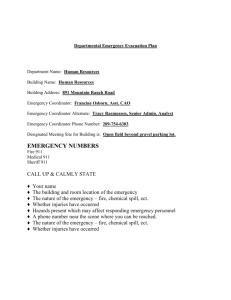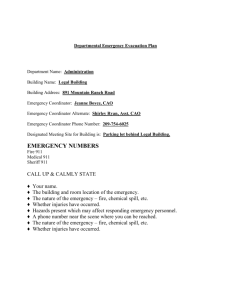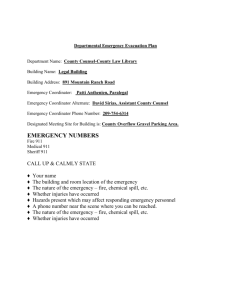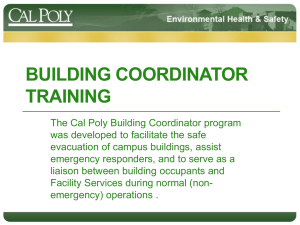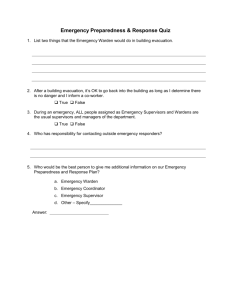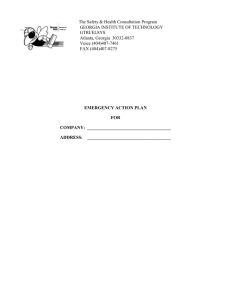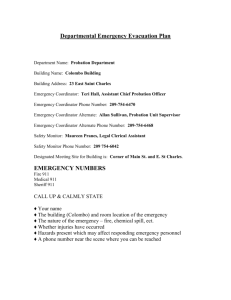Departmental Emergency Evacuation Plan
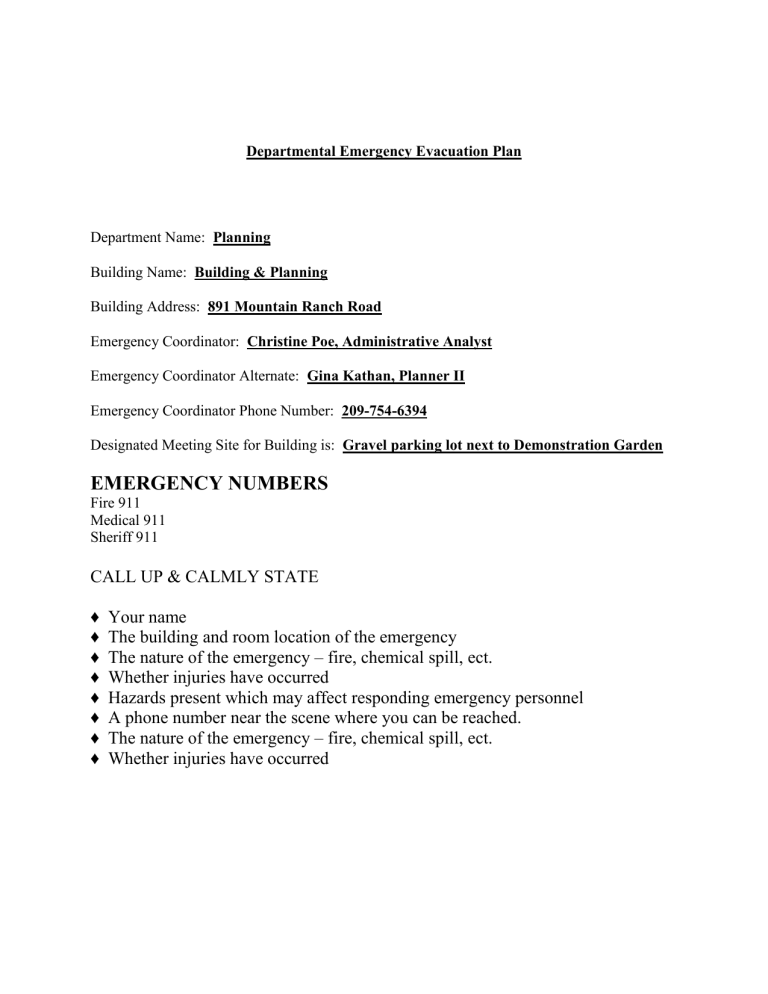
Departmental Emergency Evacuation Plan
Department Name: Planning
Building Name: Building & Planning
Building Address: 891 Mountain Ranch Road
Emergency Coordinator: Christine Poe, Administrative Analyst
Emergency Coordinator Alternate: Gina Kathan, Planner II
Emergency Coordinator Phone Number: 209-754-6394
Designated Meeting Site for Building is: Gravel parking lot next to Demonstration Garden
EMERGENCY NUMBERS
Fire 911
Medical 911
Sheriff 911
CALL UP & CALMLY STATE
♦ Your name
♦ The building and room location of the emergency
♦ The nature of the emergency – fire, chemical spill, ect.
♦ Whether injuries have occurred
♦ Hazards present which may affect responding emergency personnel
♦ A phone number near the scene where you can be reached.
♦ The nature of the emergency – fire, chemical spill, ect.
♦ Whether injuries have occurred
TABLE OF CONTENTS
Section I: Purpose and Objectives
Section II: General Guidelines
Section III: Responsibility of Emergency Coordinator and Safety Monitors
Section IV: Alerting or Signaling Building Occupants in Case of Fire or Other Emergency
Section V: Evacuation Procedure for Building Occupants
Section VII: Critical Operations Shutdown
Section VIII: Accountability Procedures for Emergency Evacuation
Section IX: Rescue and Medical Duties
Section X: Resource and Responsibilities Lists
Section XI: Training and Communications Appendices
Appendix I:
Emergency Evacuation
Plan Responsibilities Lists.
Appendix II:
Site Specific Information
Building Floor Plans
Primary and Secondary Emergency Evacuation Routes
Designated Meetings Sites
Exits
Fire Alarm Box Locations
Appendix III:
Area Evacuation Plan
Appendix IV:
OSHA Regulation 29 CFR 1910.38
Employee Emergency Plans and Fire Prevention Plans
SECTION I: PURPOSE AND OBJECTIVES
Potential emergency in the Planning Department Building, such as fire, explosion, spill, chemical releases and all other emergencies require employees to evacuate the building. An
Emergency Evacuation Plan (EEP) and adequate familiarity with a building minimize threats to life and property. In addition, the Occupational Safety and Health Administration OSHA
Emergency Action Plan standard, found at 29 CFR 1910.38(a), requires that the Planning
Department has a written EEP. This plan applies to all emergencies where employees may need to evacuate for personal safety.
This EEP is intended to communicate the policies and procedures for employees to follow in an emergency situation. Under this plan, employees will be informed of:
• The Plan’s Purpose.
• Preferred means of reporting fires and other emergencies.
• Emergency escape procedures and route assignments,
• Procedures to be followed by employees who remain to control critical plant operations before they evacuate,
• Procedures to account for all employees after emergency evacuation has been completed.
• Rescue and medical duties for those employees who perform them,
• The alarm system.
Christine Poe, Administrative Analyst is the Emergency Coordinator for this facility and has overall responsibility for the preparation and implementation of this plan.
Gina Kathan, Planner II is the Alternate Emergency Coordinator.
The Emergency Coordinator will review and update the plan as necessary. Copies of this plan will be maintained in the Human Resources Department.
SECTION II: GENERAL GUIDELINES
The following guidelines apply to this EEP:
1.
All personnel must be trained in safe evacuation procedures. Refresher training is required whenever the employee’s responsibilities or designed actions under the plan change, and whenever the plan itself is changed.
2.
The training may include use of floor plans and workplace maps which clearly show the emergency escape routes included in the EEP. Floor plan should be posted at all times in main areas in Planning Department to provide guidance in an emergency.
3.
No employee is permitted to re-enter the building until advised by the Emergency
Coordinator.
SECTION III: RESPONSIBILITIES OF EMERGENCY COORDINATOR
AND SAFETY MONITORS
The Emergency Coordinator is responsible for:
1.
Obtaining and posting floor plans and route evacuation maps.
2.
Overseeing the development, communication, implementation and maintenance of the overall EEP.
3.
Ensuring the training of building occupants, Safety Monitors, and Critical
Operations Personnel, and notifying all personnel of Changes to the plan.
4.
Maintaining up to date lists of building occupants, critical operations personnel, and any other personnel with assigned duties under this plan. Lists are included in Appendix I.
5.
In the event of a fire or other emergency, relaying applicable information to emergency personnel, occupants and Safety Monitors.
6.
Establishing Designated Meeting Sites for evacuees.
The Safety Monitors are responsible for:
1.
Familiarizing personnel with emergency procedures.
2.
Acting as liaison between management staff
3.
Ensuring that occupants have vacated the premise in the event of an evacuation, and for checking assigned areas.
4.
Knowing where their Designed Meeting Site is and for communicating this information to occupants.
5.
Having a list of personnel in there area of coverage or Department, so a head count can be made at the designated meeting site.
6.
Ensuring that disabled persons and visitors are assisted in evacuating the building.
7.
Evaluating and reporting problems to the Emergency Coordinator after an emergency event.
8.
Posting the “Area Evacuation Plan” (Appendix III) in their work areas, communicating plan to occupants, and updating the plan annually.
SECTION IV: ALERTING OR SIGNALING BUILDING OCCUPANTS IN
CASE OF FIRE OR OTHER EMERGENCY
1.
Persons discovering the a fire, smoky condition, or explosion should dial 9-911.
2.
Since the Planning building does not have fire alarm boxes, shouting the alarm of a fire or other emergency can be done while exiting.
3.
Safety Monitor are to follow procedures in Section III.
SECTION V: EVACUATION PROCEDURES FOR BUILDING
OCCUPANTS
1.
When an employee shouts alarm of a fire, all personnel should ensure that nearby personnel are aware of the emergency, close doors, windows and exit the building.
2.
All personnel and occupants should proceed to the gravel parking lot next to the
Demonstration Garden and await further instructions from the Emergency
Coordinator or their Safety Monitor.
3.
All personnel should know where primary and alternate exits are located, and be familiar with the various evacuation routes available. Floor plans with escape routes, alternate escape routes, exit locations and Designated Meeting Sites are located in Appendix II and are posted in the building.
Notes and Precautions: a.
Small fires can be extinguished only if you are trained to use a fire extinguisher. However, an immediate readiness to evacuate is essential. b.
All fires, even those that have been extinguished, must be reported to 9-
911 immediately. c.
Never enter a room that is smoke filled d.
Never enter a room if the door is warm to touch.
FIRE:
R – Rescue: When you discover a fire, rescue people in immediate danger if you can do so without endangering yourself. Exit via safe fire exit. Close door to room with fire.
A – Alarm: Sound Alarm by shouting fire (location) and call 9-911.
C – Confine: Close all Doors, Windows and other openings
E – Evacuate: Evacuate the building.
SECTION VI: DISABLED OCCUPANTS
If a disabled occupant is unable to exit the building unassisted, the Safety Monitor must notify the emergency response personnel of the person’s location.
SECTION VII: CRITICAL OPERATIONS SHUTDOWN
Critical operations, including equipment that must be shut off and persons designated to complete these actions are identified in Appendix I of this EEP. Procedures for rapid shutdown should be predetermined for life safety and loss control purposes, as well as ensuring complete evacuations in a timely manner.
The Critical Operations Shutdown procedure to be followed by those employees who have been assigned to care for essential building operations include:
OPERATION
1.
2.
RESPONSIBILITY
Equipment Shut off
Equipment Shut off
Persons involved in the Critical Operations Shutdown listed above shall be notified by management of this responsibility in advance, identified in the EEP, and will be appropriately trained for the particular situation. Personnel assigned to critical operations responsibilities are listed in Appendix I.
SECTION VIII: ACCOUNTABILITY PROCEDURES FOR EMERGENCY
EVACUATION
Designated Meeting Sites: Groups working together on or in the same area should meet outside the building in the prearranged Designated Meeting Site. A list of the primary Designated
Meeting Sites is listed on the floor plans in the Appendix II.
Department Organization List: A roster of Planning Department personnel has been developed to ensure that everyone has evacuated. It will be the responsibility of the Emergency
Coordinator to update when ever there is a personnel change.
Safety Monitors are designated by the Emergency Coordinator and will conduct head counts once evacuation has been completed and will report to the Emergency Coordinator.
The employee selected as Safety Monitor is to be trained in the complete workplace layout and the various escape routes from the workplace. All trained personnel are made aware of employees with disabilities that may need extra assistance, and of hazardous areas to be avoided
during emergencies. Before leaving, the Safety Monitor is to check rooms and other enclosed spaces in the workplace for other employees or occupants who may be trapped or otherwise unable to evacuate the area, and convey this information to emergency personnel. A list of the
Safety Monitor and Alternate the Planning Building appears in Appendix I.
Once each evacuated group of employees have reached their Designated Meeting Site, the Safety
Monitor:
1.
Assembles his/her group in the Designated Meeting Site.
2.
Takes head count of his or her group.
3.
Assumes role of department contact to answer questions.
4.
Instructs personnel to remain in area until further notice.
5.
Reports status to Emergency Coordinator or Incident Commander
6.
Instructs personnel to remain at Designated Meeting Site until further notice.
SECTION IX: RESCUE AND MEDICAL DUTIES
The Fire Department and/or Emergency Medical Technicians (EMT) will conduct rescue and medical duties. Do not move injured personnel, keep the person lying down, covered and warm.
SECTION X: RESOURCE AND RESPONSIBILITIES LISTS
EEP Organization: The lists in Appendix I include the names of employees, managers, staff or other personnel and their job titles, job positions and relative EEP collateral duties.
1.
To tell employees who to see for additional information on the EEP.
2.
To provide emergency response personnel with a list of department personnel which may be needed in order to provide additional information about the fire, a chemical, a hazardous waste location, a shipment of chemicals, ect.
3.
The lists should be updated by the Emergency Coordinator on an as needed basis.
SECTION XI: TRAINING AND COMMUNICATIONS
Each employee should know that the evacuation is necessary and what his/her role is in carrying out the plan. Employees should also know what is expected of hem during an emergency to assure their safety. Training on the EEP content is also required by OSHA 29 CFR 1910.38(a).
A method of training employees in the requirements of the emergency evacuation plan is to give all employees a thorough briefing and demonstration upon hiring. Annual practice drills are to be implemented and documented by the Emergency Coordinator.
A Training Attendance Record Sheet is included in Appendix I. This record should be maintained by the Emergency Coordinator for period of five (5) years.
APPENDIX I:
EMERGENCY EVACUATION PLAN RESPONSIBILITIES LIST PLANNING
DEPARTMENT.
Department Name: Planning
Building Name: Building & Planning Building
Address: 891 Mountain Ranch Road, San Andreas, CA 95249
Title Name Location Telephone
Emergency
Coordinator __Admin Analyst Christine Poe Analyst Office 754-2801_______
Alternate Emergency
Coordinator __Planner II ____Gina Kathan __Current Planning Center Cubicle 754-2853
Safety Monitor General Plan Coord. Brenda Gillarde Advance Plan Office 754-2874
Alternate
Safety Monitor _Planner III Dave Pastizzo Advance Plan Office 754-2855
Total Number of
Employees____________8______________________
PERSONNEL ASSSIGNED TO CRITICAL OPERATIONS RESPONSIBILITIES
Critical Operation Required Shutdown Name Job Position Work Area
2.
3.
4.
5.
6.
7.
8.
PLANNING DEPARTMENT EMPLOYEE LIST
1. George White
Christine Poe
Brenda Gillarde
Dave Pastizzo
Gina Kathan
Debra Lewis
Dennis Gomes
Annette Huse
Planning Department
Administrative Analyst
General Plan Coordinator
Planner III
Planner II
Planner III
Planner II
Permit Technician
UTILITIES EMERGENCY MAINTENANCE
PERSONNEL TO CONTACT IN THE EVENET OF AN EMERGENCY
UTILITY
Any Emergency
ELECTRICITY
NAME
Dave Allen
Kevin Brady
DEPARTMENT TELEPHONE
911
Bldg. & Grounds 754-6704
Cell 768-7126
Bldg. & Grounds 754-6704
Cell – 768-7126
WATER
GAS
PG&E
Dave Allen
CPUD
Dave Allen
Bldg. Grounds
Bldg & Grounds
Calaveras County
Departmental Safety Meeting
Department Name:
Presenter/Trainer:
Safety/Discussion Topic:
Employee Name ( please print legibly )
Attendance & Information Sheet
Date:
Employee Signature
Department Safety Meeting Information Sheet
1.
What are the learning objectives for this program?
2.
How were these objectives met? (Example: lecture, discussion, video, demonstration, etc.)
3.
What information was covered in the program?
4.
What prompted this topic for your safety meeting?
Regulatory Need Employee Request
Need from Incidents/Issues Annual Training
New Equipment New Process
Tailgate Discussion
Department Committee Member/Trainer Signature
County Safety Committee
Date
APPENDIX II
♦
Building Floor Plan
♦
Primary and Secondary Emergency Evacuation Routes
♦
Designated Meeting Sites
♦
Exits
♦
Fire Alarm Box Locations
APPENDIX III
Area Evacuation Plan
(post and update annually)
Department/Area: ____________________________________________________________
Date:____________________________________Completed By:_______________________
1.
Primary Evacuation Route:
2.
Designated Meeting Site:
3.
Safety Monitor :______________________________
Alternate Safety Monitor __________________________________
Emergency Coordinator for the Building _____________________________________
Check List of Responsibilities for the Safety Monitor:
1.
Ensure the R.A.C.E.
is followed if smoke or flame are discovered in your work area:
r escue
a larm
c lose all doors
e vacuate
2.
“Sweep” every room in your area to make sure that everyone has evacuated.
3.
Ensure that people follow the appropriate evacuation route, and that they are directed to a safe, post-evacuation meeting place.
4.
Account for all staff and visitors at the Designated Meeting Site
5.
Identify yourself as the safety Monitor for your work area to the Emergency
Coordinator and emergency responders.
6.
Notify Emergency Coordinator and emergency responders of any personnel who remain trapped in building, are performing critical operations shutdown, or are unaccounted for.
Special Needs
1. Be aware of impaired staff and visitors who may need to be alerted assisted.
Laboratories & Maintenance Areas
1.
Contact Building & Grounds


